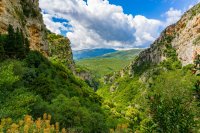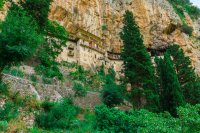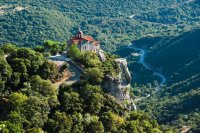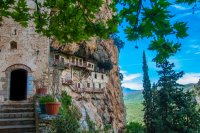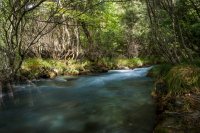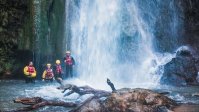The Castle, the village and the gorge (Lousios gorge)
On the old Greek five thousand money paper, that some still remember, there was a castle on their back side. That is why most Greek “newcomers” found it oddly familiar, contrary to the (completely made of stone) village that keeps the excitement of the exploration intact.
One of the most beautiful castles of Peloponnese
Placed on a steep, and somehow conical, rock, on top of which stone walls and battlements hug, Karitena’s castle is Frankish and built in the 13th century probably- but not surely- at the place of the oldest, byzantine and probably ancient castle. History has it that during the Greek Revolution Kolokotronis, our national hero, had settled there to use it as a base, as well as Ibrahim, the Turkish rival, that tried but didn’t succeed in conquering it.
At night, the yellow lights that make it look like it’s hanging from the sky are spectacular. The access to the castle is easy, as the road goes smoothly up the rock starting from the stone path that begins from the central square of Karitena. The panoramic view from the castle’s walls of the village, the Megalopolis valley and the green mountain sides that hug it, is a reason all by itself to go up there.
Strolling at the village…
…is delightful every hour of the day, but especially during the sunset, where the stone-built alleys and the stone houses with the red tiled roofs are bathed in the soft orange gold light of the sun as it sets behind the Arcadian mountains. Spread among the village’s cobbled streets you will meet byzantine churches like Zoodochos Pigi of the 16th century with the three-storied bell tower that adorns the main square, and the little stone chapel of St. Nicholas with the tiles on its dome that dates back to 1831. The also stone-built fountains gush crystal clear water, while the picturesque cafeterias of the square are ideal for the breaks from your strolls around the village.
Two rivers, many thrills
Apart from the village that is worth viewing on its own, Karitena is the ideal base for one of the most popular “adventures” of the Peloponnese, rafting at Lousios and Alfios rivers. The beginners should not be afraid because first of all it is not dangerous at all, and secondly the landscapes you see along the river there is no other way to see them. And they are, indeed, some of the most exquisite ones you have ever seen: At the shores of the two rivers nature starts its dance, the gigantic white rocks that hug them create strange formations, the arched bridges look like they came out of a fairytale, and at the end of the rafting route awaits a marvelous cataract in the shadow of which you can easily imagine fairies dancing.
The descents (as the routes are called in rafting), beginning from a pocket sized village called Vlachorafti 14 kilometers away from Karitena, last almost two hours all year round. If you are not a beginner, the best month to visit is April that the snow melts, Lousios waters inflate and the descent is quick and amazing. If you are a beginner, the best seasons to visit are summer and autumn because the descent is slower, as the water is fewer, and you have more time to enjoy the landscape.
Lousios Gorge
The lovers of hiking, probably have heard that this is one of the most beautiful gorges in Peloponnese. Its name is Lousios since the nymphs, according to mythology, bathed in the waters the newly- born Zeus.
The gorge’s length is 15 kilometers approximately- Lousios is a small river that its waters cross just 26 kilometers before they reach Alfios River. If you are not willing to walk it, a quite shorter but rather astonishing hiking route is the one that starts from Ancient Gortynia, 12 kilometers away from Karitena, and after a kilometer and a half ends up in the carved on the rock Monastery of Prodromos, following the flow of the river and passing by old watermills and over small bridges. The monastery is open for visit, dating back to the middle of the 12th century, and has on the interior impressive frescoes of the 16th century.
From the Monastery of Prodromos starts a phantasmagoric route that after 1.200 meters leads you to the famous Philosophou old monastery, which was founded in 963 A.C. by the byzantine emperor’s, Nikiforos Fokas, secretary. At the most beautiful spot of the gorge there is a region called Monopori, the Philosophou old monastery which is one of the oldest byzantine monuments in the entire Greece. People call it “Krifo Scolio” (secret school) because here operated a school, during, the Ottoman ruling, that evolved as the well-known Hieratic school of Dimitsana at the Philosophou new monastery-which is not that new, as it was founded in 1691, and it is open for visit, 500 meters away from the old monastery, in a more easily accessible point.
The most ancient city in the world (?)
Twenty four kilometers south of Karitena, the ancient Lykosoura, nestled on the side of Lykaion Mountain, in a magical place, is the one that Pausanias considers as the most ancient city of the world. <<The oldest of all the cities on land and islands, Lykosoura is the most ancient and the first city that saw the sun, the one from which the rest of humanity was taught how to build cities>> writes in his Arcadika (VIII.38.1). And even if Pausanias is quite excessive and overenthusiastic sometimes, it remains to be proved since the ancient Lykosoura, as the rest of the remaining antiquities of Lykaion Mountain have not yet be excavated sufficiently, which means that we don’t know when the city was established yet.
Nowadays, at the archaeological site of Lykosoura are saved some pieces of the Acropolis wall of the 5th century B.C. and of Despina’s sanctuary, which Pausanias writes that the Arcadians worship more than the other gods, rushing to clarify that Despina is not the name of the goddess but an epithet that the believers used. <<I was afraid to write about Despina’s name to the uninitiated>>, he concludes.


